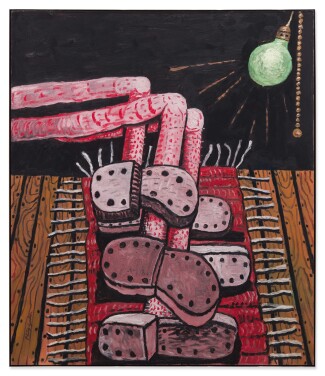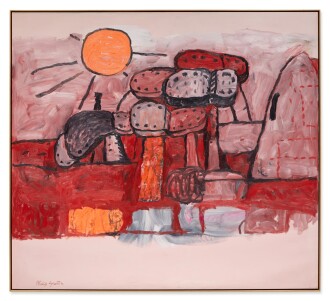Works by Philip Guston at Sotheby's
Philip Guston Biography
Philip Guston, born in Montreal, Canada, in 1913, was the son of Russian Jews who immigrated to America to escape persecution. In 1919, the family moved to Los Angeles, but hardship pursued the family; poor professional prospects for Guston’s father coupled with racism, specifically related to the rise of the Klu Klux Klan, led to tenuous financial security. These early difficulties, compounded by his father’s suicide when he was seven, left an indelible mark on the artist. He began work on his first paintings at age 14, and in 1927 he was enrolled at Manual Arts High School in Los Angles (where he later met and befriended Jackson Pollock). While there, he studied Cubism as well as mysticism, and in 1930 received a scholarship to attend Otis Art Institute—the following year he had is first solo exhibition.
In 1935, and partially due to the encouragement from Pollock, Guston relocated to New York City, where his interest in social issues and activism led him to work for the Works Progress Administration (WPA) Mural Division. The position was a natural fit, as Guston had previously endeavored to complete full-scale murals on his family’s property when still a teenager. While working for the WPA, he produced numerous murals throughout the United States, including one for the New York World’s Fair. By the early 1940s, the artist returned to easel painting, which allowed for easier, in-depth exploration and experimentation with style and technique.
Over the following years, his work began to exhibit the stylistic hallmarks of his oeuvre, including assertive brushwork, a distinctive color palette, and—although at odds with the rise of Abstract Expressionism—a unique form of cartoonish figuration. Some of the figures that populate several of his paintings directly reference Klansman, no doubt sourced from his early exposure to the group as a child. Other recurring motifs include light bulbs, cigarettes and disembodied limbs. Despite these works being positioned solidly within the realm of art historical canon, they were initially derided by critics, and ultimately led to his loss of gallery representation for a short while.
In the late 1970s, Guston began to reintroduce total abstraction into his work, however, the endeavor never fully materialized as he died suddenly from a heart attack in 1980. Although much of his oeuvre consists of works done within the Abstract Expressionism mode, his works of the 1970s have come to define his legacy, and, today, Guston is considered one of the key progenitors of Neo-Expressionism. His works are included in many major collections worldwide, including the Centre Georges Pompidou, Paris; the Tate Modern, London; the Museum of Modern Art, New York; and the Art Institute of Chicago.












